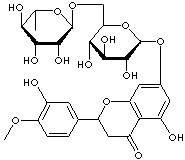|
DIOSMIN |
| Synonyms. Diosmin; 3',5,7-Trihydroxy-4'-methoxyflavone-7-(6-O-(-deoxy-alpha-L-mannopyraonsyl)- beta-D- glucopyranoside; 3',5-Dihydroxy-4'-methoxy-4-oxo-4H-chromen-7-ylrutosid; 5-Hydroxy-2- (3-hydroxy-4- methoxyphenyl)-7- ((6-O-alpha- L-rhamnopyranosyl-beta-D-glycopyranosyl) oxy)-4- chromenon; Barosmin; 7-((6-O-(6-Deoxy-ga-L-mannopyranosyl)-beta-D-glucopyranosyl)oxy)-5- hydroxy-2-(3- hydroxy- 4-methoxyphenyl)-4H-1-benzopyran-4-one; Daflon; Diosmetin-7-O-rutinoside; Diosmil; Diosmin; Diosmine; Diosminum; Diovenor; Flebosten; Rioven; Tovene; Ven-Detrex; Venosmine; |
|
|
| PRODUCT IDENTIFICATION | |
|
CAS RN |
520-27-4 |
|
EINECS RN |
208-289-7 |
|
FORMULA |
C28H32O15 |
|
MOLE WEIGHT |
608.54 |
|
H.S CODE |
2932.99.6100 |
|
SMILES |
c1(cc(c2c(o1)cc(cc2O)O[C@H]1[C@H](O)[C@@H](O) [C@H](O) [C@H ](O 1)CO[C@H]1[C@H](O)[C@H](O)[C@@H](O) [C@@H](O1)C)=O)c1ccc (cc1)O C |
|
CLASSIFICATION |
Flavone Glycoside |
|
EXTRA NOTES |
Diosmin is a semisynthetic drug (modified hesperidin), a member of the flavonoid family. It is an oral phlebotropic drug used in the treatment of venous disease, i.e., chronic venous insufficiency (CVI) and hemorrhoidal disease (HD), in acute or chronic hemorrhoids, (Wikipedia). |
|
|
| PHYSICAL AND CHEMICAL PROPERTIES | |
|
PHYSICAL STATE. |
yellow powder |
|
MELTING POINT |
274 C |
|
BOILING POINT |
|
|
DENSITY |
|
|
SOLUBILITY IN WATER |
Practically insoluble |
| SOLVENT SOLUBILITY |
Dissolves in dilute alkali hydroxides, practically insoluble in alcohol |
|
VAPOR DENSITY |
|
|
log P(octanol-water) |
|
|
VAPOR PRESSURE |
|
|
AUTOIGNITION TEMP |
|
| pK |
|
|
REFRACTIVE INDEX |
|
|
FLASH POINT |
|
|
|
| STABILITY AND REACTIVITY | |
| STABILITY | Stable under normal conditions. Hygroscopic. |
|
INCOMPATIBLE MATERIALS |
Strong oxidizing agents. |
| POLYMERIZATION |
Has not been reported |
|
NFPA RATINGS |
Health: 1, Flammability: 0, Reactivity: 0 |
|
|
| EXTERNAL LINKS & GENERAL DESCRIPTION |
|
Wikipedia Linking - Diosmin Google Scholar Search - Diosmin Drug Information Portal (U.S. National Library of Medicine) - Diosmin PubChem Compound Summary - Diosmin KEGG (Kyoto Encyclopedia of Genes and Genomes) - Diosmin http://www.ebi.ac.uk/ - Diosmin http://www.ncbi.nlm.nih.gov/ - Diosmin http://findarticles.com http://www.uhealth.net/ |
|
|
| SALES SPECIFICATION | |
|
APPEARANCE |
yellow hygroscopic powder |
|
ASSAY |
90.0% min |
|
WATER |
6.0% max |
|
SULFATED ASH |
0.5% max |
|
PARTICLE SIZE |
75µm (100%) |
|
MELTING POINT |
260 ~ 265 C |
|
HEAVY METALS |
20ppm max |
|
|
| TRANSPORT & REGULATORY INFORMATION | |
|
UN NO. |
Not regulated |
| HAZARD CLASS |
|
| PACKING GROUP | |
|
|
| SAFETY INFORMATION |
|
|
HAZARD OVERVIEW |
May be harmful if inhaled. May cause respiratory tract irritation. May be harmful if absorbed through skin. May cause skin irritation. May cause eye irritation. May be harmful if swallowed. |
| HAZARD CODES |
|
|
RISK PHRASES |
|
|
SAFETY PHRASES |
26-36 |
|
|
| PACKING |
|
Preserve in light-resistant and well-closed containers |
